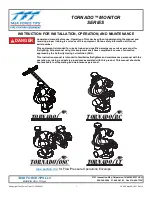
•
Verify that a live video image appears on the screen by pointing the distal end of the
aScope™ Duodeno towards an object, e.g. the palm of your hand and make sure that the
orientation of the image is correct.
•
Adjust the image preferences if necessary, by accessing the settings and information menu
of the aBox™ Duodeno. For detailed information please refer to the aBox™ Duodeno IFU.
•
Angulate the endoscope distal end and confirm there are no disruptions to the live image,
nor are there any other irregularities or noted artifacts.
•
If the image is impaired and/or unclear, wipe the lens at the distal end using a sterile cloth.
Check of the Remote Switches
All remote switches should be checked to work normally even if they are not expected to be used.
The endoscopic image may freeze or other irregularities may occur during examination and may
cause patient injury, bleeding, and/or perforation.
•
Press every remote switch and confirm that the specified functions work as expected.
Checking the endoscope's suction, rinsing and insufflation functionality
•
Check that the suction and insufflation/rinsing valve work as expected by pressing the
suction and rinsing valve. Cover the opening of the insufflation valve and confirm that the
corresponding function works properly.
4.4
Operating The aScope™ Duodeno
Insertion of the Endoscope
9
•
Insert a suitable mouthpiece and place it between the patient's teeth or gums.
•
Make sure the elevator is not raised before you insert the endoscope.
•
If necessary, apply a medical-grade lubricant to the insertion section.
•
Insert the distal end of the endoscope through the opening of the mouthpiece, then from
the mouth to the pharynx while viewing the endoscopic image. Do not insert the insertion
section into the mouth beyond the insertion section limit mark.
Holding an manipulating the endoscope
•
The control section of the endoscope is designed to be held in the left hand.
•
The insufflation/rinsing and suction valves can be operated using the left index finger.
•
The UP/DOWN angulation control wheel and the elevator control lever can be operated
using the left thumb of the left hand.
•
The right hand is free to manipulate the insertion section and the RIGHT/LEFT angulation
control wheel.
Angulation of the Distal End
•
Operate the angulation control wheels as necessary to guide the distal end for insertion
and observation.
•
The endoscope’s angulation locking levers are used to hold the angulated distal end in
position.
Insufflation/Rinsing
•
Cover the insufflation/rinsing valve’s hole to feed air from the insufflation/rinsing valves
at the distal end. Press the insufflation/rinsing valve to feed water onto the objective lens.
Instillation of Fluids
•
Fluids can be instilled through the working channel by inserting a syringe into the working
channel port of the aScope™ Duodeno. Insert the syringe completely into the working
channel port and press the plunger to instill fluid.
•
Make sure you do not apply suction during this process, as this will direct the instilled fluids
into the suction collection system. To ensure that all fluids has left the channel, flush the
16












































